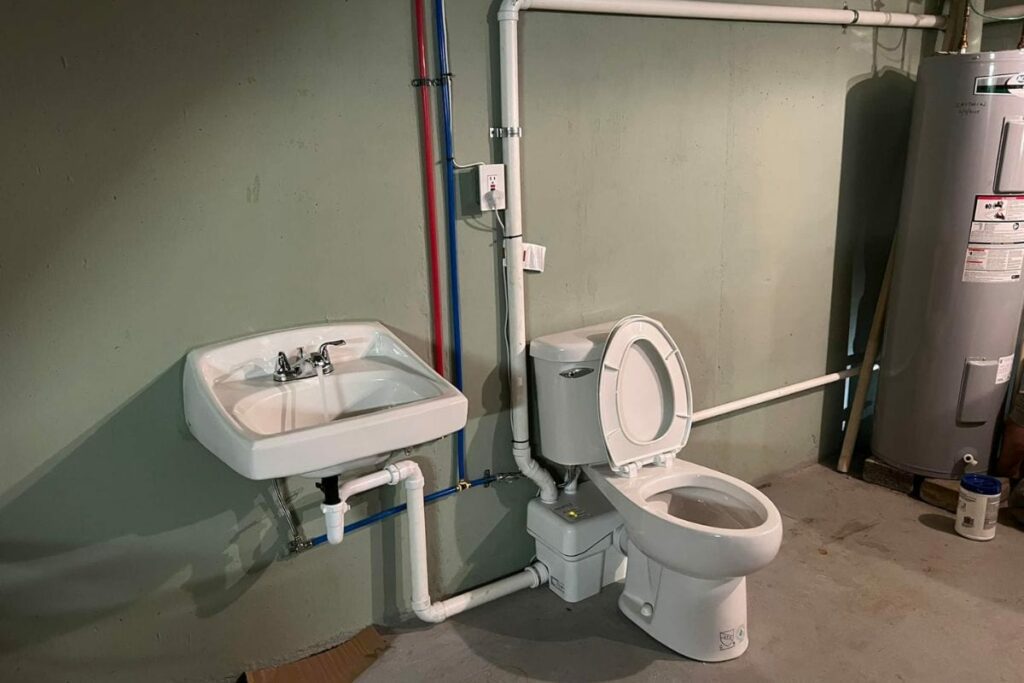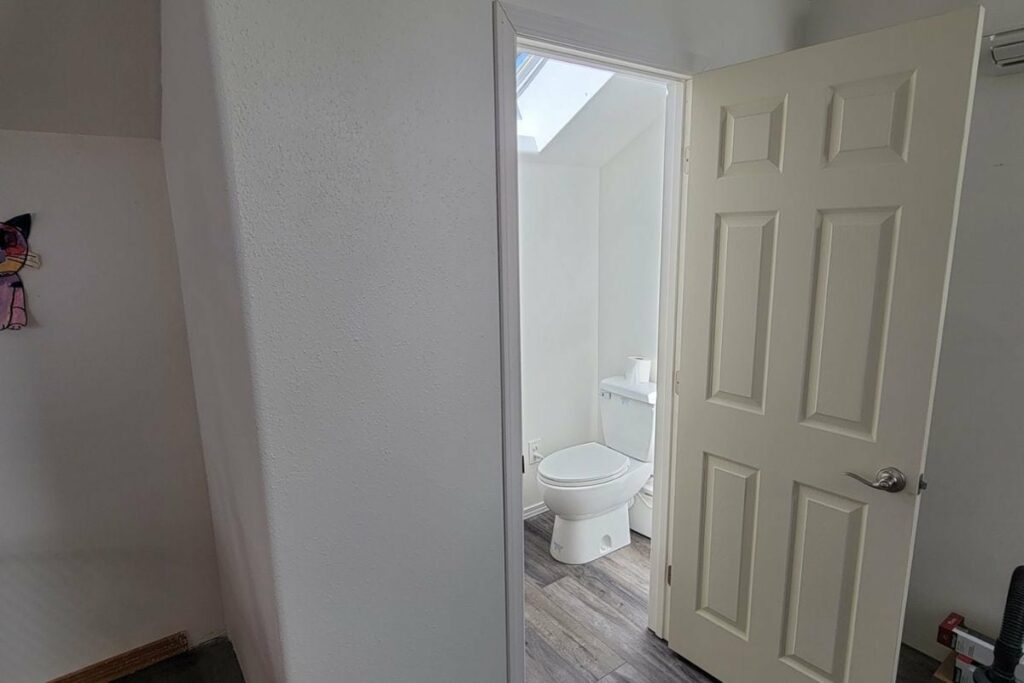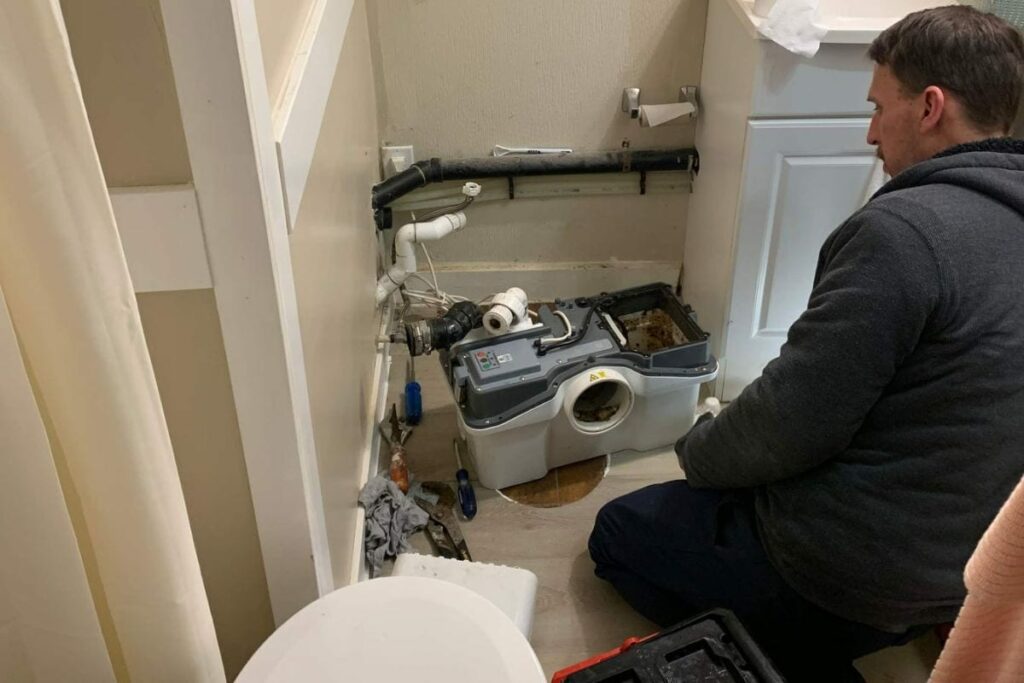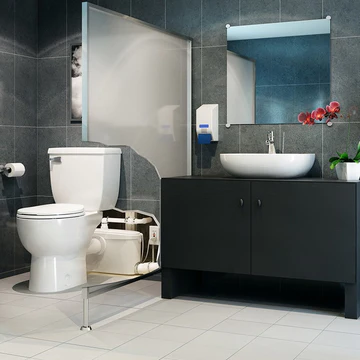Are you considering installing a toilet in your basement below the main plumbing stack or a room too far from it? A regular gravity-fed toilet is certainly out of the question. So, what can you do? Well, a macerating toilet can be a great option for you.
A macerating toilet, also called an upflush toilet differs from a gravity-fed toilet in handling the waste. Rather than sending the waste directly to the sewage, a macerating toilet sends it to a chamber where it is liquified by heavy-duty steel blades before pumping it to the sewage line.
While macerating toilets can be a bit more expensive than regular toilets, they are much cheaper than redoing the entire plumbing of your home to install a toilet in a room. Let’s look at how a macerating toilet works, whom it is suited for, and whether you should get one installed in your home!
How Does a Macerating Toilet Work?
While a macerating toilet looks very similar to your conventional toilet, its operation is very different. Once you flush a macerating toilet, the waste is first crushed to a pulp in a chamber, and the slurry thus formed is then pumped with a heavy-duty trash pump into the sewage line.
A macerating toilet collects the waste in a tank called a macerator, usually located behind the tank or the flush tank. Once you flush the toilet, the water, and solid waste get collected in the macerator. Once the macerator fills to a pre-determined level, the blades in the macerator turn on automatically, grinding the waste into a fine pulp. The ‘macerated’ waste is pumped through a PVC pipe to the main sewer line.
Depending on the power of your slurry pump, a macerating toilet can pump waste 15 feet upward or about 150 feet horizontally.
When to Install a Macerating Toilet?

You should consider a macerating toilet only if a traditional toilet can’t be installed or is highly impractical in the given situation. The following cases are ideal for a macerating toilet installation-
- If you are trying to install a toilet below the plumbing stack
- If you are installing a toilet far from the plumbing stack
- If you are installing a toilet temporarily, say, in a guest room
- If you have a space crunch and want to install a toilet in a small space
- If about 3-4 people are using the toilet
Depending on the strength of the trash pump, you can have the toilet 10-15 feet below the level of your sewer line or up to 150 feet away horizontally.
Remember, a macerating toilet is not an ideal solution for a large family. If you have more than four people using the bathroom, you are better off using a gravity-fed system.
How to Install a Macerating Toilet in Your Home?
While you can install a macerating toilet by yourself, it would require a bit of plumbing experience. If you are unsure that you might be unable to handle the installation, you should seek professional help. A plumber can help you install a macerating toilet in about 3-4 hours.
If you prefer to do the job yourself, here are a few things that you will need an access to-
- Discharge PVC pipe; I recommend getting a line with a 1-inch diameter.
- Venting source
- Water supply for the flush tank
- Electricity source, preferably with a circuit breaker, and
- A macerating toilet assembly
Once you have all the necessary tools, you can begin the installation process.
1. Installing the discharge pipe
The first step is to connect the discharge pipe with the toilet. Double-check the discharge pipe size. Use a discharge pipe that is compatible with your toilet. Also, rather than using 900 bends, use 450 elbows.
2. Connect the water system
In the next step, you need to connect the water system to the flush tank.
3. Electric supply
You will need a 15-ampere cable to plug in the macerating toilet.
4. Vent the pump
You can vent the pump in your home’s venting system so that air can move in and out of the system. You can also install a new venting system for your macerating toilet if you want.
Installing a macerating toilet requires a keen eye for detail. If you mess up the installation process, you can have a mini catastrophe on your hand! So, if you are unsure you can handle it, it is better to call a professional to help you.
Ensure that the installation of your macerating toilet is up to code and that you don’t get into trouble with local authorities.
What are the Advantages of a Macerating Toilet?
The main advantage of this system lies in the fact that it can also dispose of waste against gravity. Consequently, you can install macerating toilets below the main plumbing stack in basements. An upflush system can be a great option, even if your room is far from the main plumbing stack.

Another advantage of these upflush systems is that you can install them in relatively small spaces. The plumbing requirements are also flexible, and professionals can install these toilets within hours without demolition.
Macerating toilets can be a great option if you want to temporarily install a toilet in your home as they are quite easy to install and relocate. You can also get one of these installed in your guest room if you are planning to remodel your home and won’t be able to use the main bathroom for some time.
If you are wondering about durability, let me tell you that macerating toilets are as durable as conventional toilets. Most commercially available macerating toilets should last 10-15 years before needing any replacement parts.
I also like that a macerating toilet uses less water per flush than a traditional gravity-fed toilet. While a normal toilet uses around 1.6 gallons of water every time you pull the flush, a macerating toilet uses only 1.2 gallons, with some requiring as low as 0.8 gallons of water per flush!
Are There any Downsides of Installing a Macerating Toilet?
While macerating can be a great choice for many, you should keep in mind some of the downsides of getting these installed in your home-

- Installing costs: The upfront installation costs of a macerating toilet are significantly more than a traditional, gravity-fed toilet. In some cases, the installation costs can be as much as twice that of normal toilets.
- Depends on electricity: As the slurry pump runs on electricity, a macerating toilet will be useless during a power cut. That said, there are battery-operated units that can solve this problem.
- The noise: A macerating toilet is essentially grinding waste so that it will make noise. However, the noise is just about as loud as the hum of a refrigerator; it is still more than the traditional toilet.
- Maintenance issues: Compared to traditional toilets, macerating toilets require more extensive maintenance. You will experience more clogging problems, and you will need to ensure that the pumps should never run dry. You will face performance issues if the pump’s impeller wears out.
- Cleaning: Unlike gravity-fed toilets, macerating toilets do have quite a lot of moving parts. You might be unable to use cleaners containing corrosive agents like bleaches and acids to clean a macerating toilet. HArd water can cause limescale buildup in the pump, which makes the toilet slow. You will need to use a specially formulated de-scaler to prevent the buildup of mineral salts in the pump.
Frequently Asked Questions
Can you install a macerating toilet in a basement?
Absolutely! You can install a macerating toilet in a basement with minimum demolition. You will have to install a couple of pipes and provide a water and electric connection to make it work.
Is a macerating toilet durable?
Modern macerating toilets are quite durable, with many manufacturers offering up to 15 years of warranty. Your macerating toilet will need regular maintenance to function optimally.
Are macerating toilets too noisy?
While macerating toilets are noisier when they operate, the noise level is between 35-45 decibels (dB), which is about the noise of a refrigerator’s hum. The noise is the highest when both the macerator and the pump work.
Parting Thoughts
A macerating toilet can be ideal for a basement or a guest room below the main plumbing stack. Although the installation can be a bit more expensive than a traditional toilet, it is still cheaper than redoing the plumbing of your basement.

Amos Christen graduated with a bachelor’s degree in Interior Design from Drexel University — Philadelphia, PA. Since 2003, Amos has worked with top interior design professionals in this area, including architects and interior/graphic/lighting designers. As a skilled interior designer, Amos Christen is highly versed in fine arts and crafts and uses that to supplement his main area of expertise. He often publishes articles related to home décor on several websites, including Sprucetoilets.com, Sprucebathroom.com, and Mybesuitedhome.com. He also contributes to leading interior design magazines.
